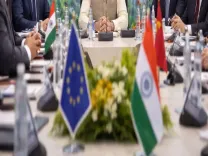What Did APEC Leaders Agree On Regarding Trade?

Synopsis
Key Takeaways
- Trade and investment must benefit all.
- Technological advancements and AI are key focus areas.
- Cultural and creative industries recognized as growth drivers.
- Consensus requires support from all 21 APEC member economies.
- Shift in trade dialogue reflects growing divergence among major economies.
Gyeongju, Nov 1 (NationPress) In a significant development, Asia-Pacific leaders have reached a consensus that trade and investment must evolve to ensure benefits for all, as reflected in a joint declaration released after their regional forum meetings.
The Asia-Pacific Economic Cooperation (APEC) embraced the Gyeongju Declaration at the conclusion of a two-day summit that brought together the 21 APEC member nations, which represent over half of the global economy.
"We reaffirm our collective understanding that strong trade and investment are essential for the growth and prosperity of the Asia-Pacific region, and we remain dedicated to enhancing economic collaboration to navigate the changing global landscape," the document stated.
"We recognize the necessity of a trade and investment framework that fosters resilience and advantages for all," it added.
The 21 APEC member economies include the United States, China, Japan, Russia, Canada, and various nations from Southeast Asia and the Pacific, along with Peru and Chile.
This year’s declaration is distinct from previous APEC statements, as it lacks language reaffirming a commitment to uphold the multilateral trade system, highlighting the increasing divergence in trade perspectives among major economies.
Key attention for this year’s APEC was whether the leaders could achieve a consensus on free trade, particularly due to the return of the Donald Trump administration with its "America First" policy and the ongoing trade tensions with China.
In recent years, most APEC economies have supported a WTO-based free trade order in their joint declarations. This year's statement notably omits any reference to the WTO system.
From 2021 to 2024, all APEC summit declarations have included mentions of a rules-based multilateral trading system with the WTO at its core, a phrase that first appeared in the 2021 declaration.
The APEC leaders' declaration requires consensus for adoption, necessitating support from every single member economy.
Beyond trade, the declaration emphasizes technological advancements driven by artificial intelligence (AI) and demographic changes—two pivotal initiatives highlighted by South Korea as this year's host, according to Yonhap news agency.
For the first time, the declaration recognizes cultural and creative industries as a new growth driver for the Asia-Pacific region and reflects a shared commitment among member economies to collaborate on AI and demographic shifts, as stated by the presidential office.
Alongside the declaration, leaders also approved two additional documents focused on an AI initiative and addressing demographic changes.










